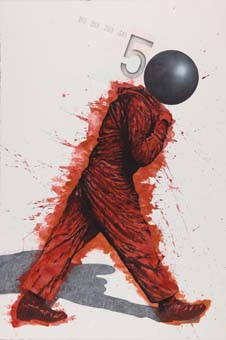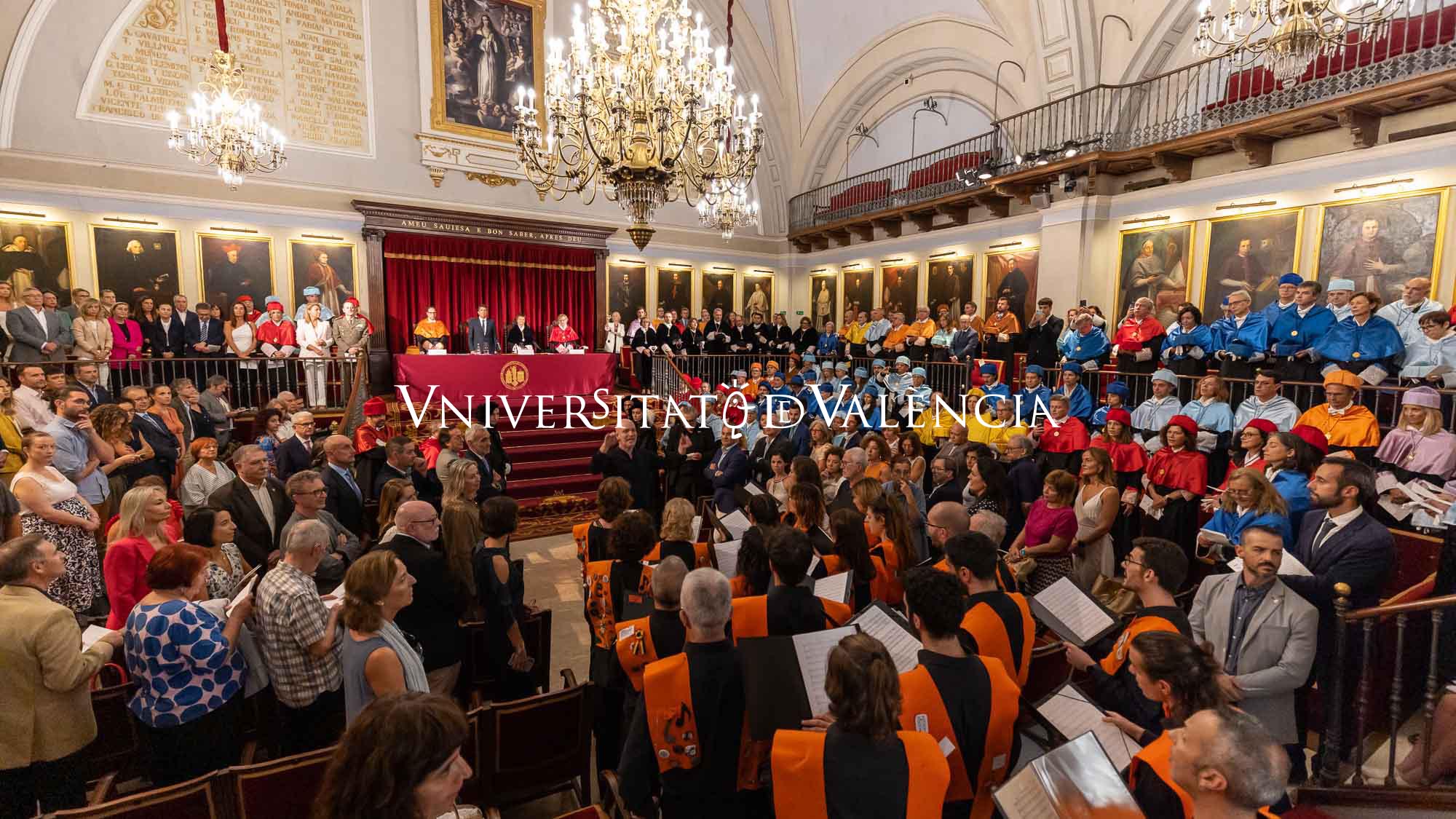
Rafael Armengol, Eduardo Arroyo, Dídac Ballester, Manuel Boix, Paula Bonet, Carmen Calvo, El Roto, Juan Genovés, Artur Heras, Mariscal, Mac Diego, Antoni Miró, Ortifus, Miquel Navarro, Ibán Ramón, Paco Roca, Jordi Teixidor or even Rosa Torres are some of the fifty designers and artists that reflect on “Cartelera Turia”, and they contribute with their work to the exhibition “50 anys en cartellera. La Turia 1964-2014”- (50 years running. Turia 1964-2014). Produced by the UV and open in La Nau.
The exhibition has been presented on Thursday in a press conference, which has been intervened by Antonio Ariño, Vice-principal Culture and Equality of the UV; Vicente Vergara, director of “Cartelera Turia”- (Turia Film Programme) and with Mila Belinchón and Toni Picazo, the people responsible for the exhibitions.
The Vice-principal of Culture and Equality of the UV, Antonio Ariño emphasized that “we couldn’t understand the Valencian culture without “Cartelera Turia”- (Turia Film Programme) that, in addition, “was born in extraordinary creativity times, the time when Fuster published “Nosaltres els valencians i Raimon”-(We, the Valencian people and Raimon), and Raimon, among other examples” and he has added that the UV should support to this project because of the pedagogical nature of the publication, which has contributed to educating citizens in cinema.
Vicente Vergara has recalled that this is the big week for publicating, since Turia Ceremony Awards will be held on Saturday and tomorrow will take place several round tables and the two responsible for the exhibition, Toni Picazo and Mila Belinchón highlighted both the contribution in modernity image of the magazine and the fruitful relationship which has always had the exhibition with graphics art and design. The exhibition, which is placed in the biggest room of the historical building of the UV, the Academy Hall, which will be open to the public untill 31 August, and compiles these artists’ work, most of them have been created “on purpose” to pay tribute to the dean Valencian leisure guide, which celebrates this year its 50 anniversary.
Each one of the works shown in the exhibition has been signed by its author and what means the Turia world for the given artists. Some of the artists reflect on the anniversary; others create their own works through erotic story, so present in the publication; there are others who base their work on music, cinema or on the burden of social criticism that features the magazine, recognized with the “Alfonso Sánchez Communication Award”, award created by the Cinema Academy, in memory of the person who was, for decades, the Spanish voice in the film criticism. In the exhibition, works created with traditional tools of analogical are shown, other created by means of digital tools and a third group of hybrid works which fuse both systems. All of them are created in a proportional format to the Turia Leisure Guide, since all of them will part of the front covers of the given Leisure Guide.
In addition to graphic and plastic works, Professor Pepa L. Poquet and her team elaborated audio-visual work “La Turia”- “Turia”, with a more personal style to celebrate the Turia Leisure Guide anniversary
The exhibition collects, too, samples of the more representative heads published in the publication.
Turia: 50 years of Leisure Guide
The Turia Leisure Guide is a cultural project, born in 1964, against politics and official culture of the Franco dictatorship, in a Valencia not resigned to its condition of still sad and dark city. It was promoted by young university students with vocation to intervene culturally in the Valencian society by means of a little information magazine and performances criticism.
During its half century of existence it has attended on time to its weekly meeting with readers, sometimes preventing political threats to be closed by its irreverent and/ or subversive character and its lack of please with established power. Dictature was uncomfortable by its criticism and the treatment of taboos for that time, but it knew to share with lecturers the possibility of new readings of reality of then, by humor and sarcasm.
With the development of democracy, the publication keeps its critical spirit, non-conformist and incisive about cultural and political establishment. It started calling itself Turia, singular masculine, and with focus on information and film criticism, but soon was opened to other arts and cultural expressions and its identity gender become a feminine noun to become La Turia, as it is colloquially known.
One of the longevity keys is, probably, its use of satire and humor as a resource to deal with deep registered changes in Valencian culture and society, during the half of century that the magazine is out.
From a journalistic analysis, in the magazine they habit two different elements and contradictory, apparently: a poplar component joined to Valencian traditional satirical press and kind of minor cultural kind or avant-garde kind. Its satirical press style has taken the publication to keep on a burlesque attitude with facto powers and cultivate in its pages iconoclastic journalistic genders, such as actual necrologies or invented exclusives.
But maybe its main contribution is the fact that it has been understood the culture as an all, joining so different subjects such as cinema, gastronomy, theatre, politics, music or sex, and from several years ago, they incorporated unclassified culture or new sections related to ecology and comic, between others.
But Turia is not a referent only for its contents, but also because of the quality of its graphic purpose. From heads to typography, coming through illustrations of inside pages or graphic humor cartoons, all graphic elements have been accurately dealt with.
Its principals saw soon that for a little pocket publication not to avoid detection for potential readers, it was needed to potentiate a strong visual identity, coherent and together with contemporary aesthetic tendencies. With this finality, they had the productive collaboration of graphic designers, illustrators, historians, publishers and too, painters, with its contribution in heads and graphic elements of inside pages was decisive to the modern image of the magazine.
Participating Artists:
Rafael Armengol
Eduardo Arroyo
Dídac Ballester
Manuel Boix
Pepe Bonache
Paula Bonet
Bru Soler
Miguel Calatayud
Rafael Calduch
Carmen Calvo
Javier Calvo
Joan Cardells
Victoria Civera
Victoria Contreras
Paco de la Torre
Maribel Domènech
Cristina Durán i Miguel Ángel Giner
El Roto
Mavi Escamilla
Juan Genovés
Manel Gimeno
Pepe Gimeno
Julio Giner
Cuqui Guillén
Artur Heras
Hyuro
Víctor Lahuerta
Sento Llobell
Mariscal
Rafael Martí Quinto
MacDiego
Antoni Miró
José María Molina Ciges
Mau Monleón
Óscar Mora
José Morea
Miquel Navarro
Ortifus
Pepa L. Poquet
Rafael Ramírez Blanco
Ibán Ramón
Paco Roca
Manuel Sáez
Bia Santos
Señor Cifrián
Jordi Teixidor
Daniel Torres
Rosa Torres
Juan Uslé
Javier Velasco
Joan Verdú
Lina Vila
Last update: 4 de july de 2014 08:00.
News release


















